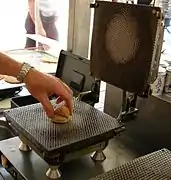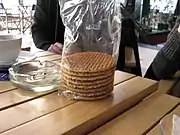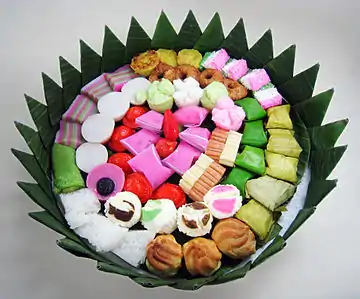Stroopwafel
A stroopwafel (Dutch pronunciation: [ˈstroːpˌʋaːfəl] ⓘ; literally 'syrup waffle') is a thin, round waffle cookie made from two layers of sweet baked dough held together by caramel filling.[2][3] First made in the city of Gouda in South Holland, stroopwafels are a well-known Dutch treat popular throughout the Netherlands and abroad.
 A plate of stroopwafels | |
| Alternative names | Syrup waffle, treacle waffle, caramel waffle[1] |
|---|---|
| Type | Waffle |
| Place of origin | South Holland |
| Created by | Gerard Kamphuisen[1] |
| Main ingredients | Batter: flour, butter, brown sugar, yeast, milk, eggs Filling: syrup, brown sugar, butter, cinnamon |
Description
A stroopwafel's wafer layers are made from a stiff dough of flour, butter, brown sugar, yeast, milk, and eggs that has been pressed in a hot waffle iron until crisp.[lower-alpha 1] While still warm, the waffles have their edges removed with a cookie cutter, which allows the remaining disc to be easily separated into top and bottom wafers. A caramel filling made from syrup, brown sugar, butter, and cinnamon—also warm—is spread between the wafers before the waffle is reassembled. The caramel sets as it cools, thereby binding the waffle halves together.[2]
Etymology and alternate terms
In Dutch, stroopwafel is a compound word literally translating to "syrup-waffle". In English, the Dutch term is commonly used verbatim, although the translated "syrup waffle" is sometimes used, "waffle" itself being a loan word from Dutch.[4] In Australia, the cookies are sometimes called "coffee toppers", in reference to the practice of placing them atop hot or warm beverages to warm the cookie and soften the caramel.
History
According to Dutch culinary folklore, stroopwafels were first made in Gouda either during the late 18th century[5] or the early 19th century[2] by bakers repurposing scraps and crumbs by sweetening them with syrup. One story ascribes the invention of the stroopwafel to the baker Gerard Kamphuisen, which would date the first stroopwafels from somewhere between 1810, the year he opened his bakery, and 1840, the year of the oldest known recipe.[2]
After 1870 stroopwafels began to appear in other cities, and in the 20th century, factory-made stroopwafels were introduced. By 1960, there were 17 factories in Gouda alone, of which four are still open.[2] Today, stroopwafels are sold at markets, by street vendors, and in supermarkets worldwide; are served as a breakfast snack by United Airlines;[6][7] and have been used as a technical challenge on a 2017 episode of the Great British Bake Off.[8]
Variants
Cookies similar to the stroopwafel may be found in parts of the Netherlands. Wafers with honey instead of syrup are sold as honingwafels, and cookies with a caramel syrup are sold as stroopkoeken. Crumbs of stroopwafels (trimmings from manufacturing) are also sold in candy cones.
A thin wafer with a sugar filling is widely known in northern France, particularly in Lille. This local waffle is known as the gaufre fourrée lilloise, which consists of two thin wafer waffles filled with cassonade sugar and vanilla. A recipe for such a waffle with vanilla filling first appeared in 1849, in the workshop of the renowned patisserie, Maison Méert, from Lille. Waffles with a filling date back to the Middle Ages, as the famous guidebook for married women, Le Ménagier de Paris, compiled in 1393, already includes recipes of waffles with a cheese filling.
Gallery
See also
- Freska – an Egyptian wafer with honey syrup filling
- IJzerkoekje – Soft cookie from the Netherlands baked on a checkered iron plate
Notes and references
Notes
- Historically waffles had a diameter of about 10 centimetres (3.9 in), but they are now available in sizes varying between 5 and 25 centimetres (2.0 and 9.8 in).
References
- "Gouda Stroopwafels (Syrup Waffles & Cookies)". Gouda Original.
- Stroopwafels. Een traditionele Goudse lekkernij Archived 4 January 2008 at the Wayback Machine Gouda-Online.nl. Retrieved on 2 January 2008. (in Dutch)
- Stroopwafel. Van Dale Taalweb. Retrieved on 2 January 2008. (in Dutch) Archived 18 February 2012 at the Wayback Machine
- "waffle". Online Etymology Dictionary. Retrieved 1 June 2023.
- History & recipe Archived 13 December 2007 at the Wayback Machine. Stroopwafelshop.com Archived 24 July 2011 at the Wayback Machine. Retrieved on 3 January 2007.
- Lazare, Lewis. "What's Stroopwafel? United Airlines embraces Dutch treat along with fast-growing list of U.S. retailers". www.bizjournals.com.
- United Airlines bringing back stroopwafels, Chicago Tribune
- "Was this the most disastrous Bake Off Technical Challenge ever?". Radio Times. Archived from the original on 22 January 2021.


.jpg.webp)
